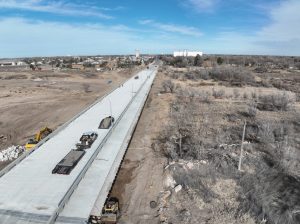Wheat Tour Day 1 results show 29.8 BPA yield in Kansas

Approximately 106 people from 22 U.S. states plus Mexico, Canada and Colombia, traveled in 27 cars on six routes between Manhattan and Colby, Kan., Tuesday, stopping at wheat fields every 15-20 miles along the routes, as part of the Wheat Quality Council’s 65th Annual Hard Winter Wheat Evaluation Tour.
Many tour participants had never stepped foot in a wheat field before and had only seen these Kansas plains from the window seat of passing airplane. These are the millers, bakers, food processors and traders who buy the wheat that Kansas farmers grow. If these fields make it to harvest, the resulting crop will go into breads, but also a number of other food items and restaurants. This tour gives Kansas farmers the chance to interact with and influence their customers around the globe, on the tour, as well as at the #wheattour23 hashtag.
Tuesday’s cars of wheat tour scouts made 318 stops at wheat fields across north central, central and northwest Kansas, and into southern counties in Nebraska. The calculated yield is based on what scouts saw at this point in time. A lot can happen between now and harvest. The calculated yield from all cars was 29.8 bushels per acre, which was nearly 10 bushels lower than the yield of 39.5 bushels per acre from the same routes in 2022.
Every tour participant makes yield calculations at each stop based on three different area samplings per field. These individual estimates are averaged with the rest of their route mates, and eventually added to a formula that produces a final yield estimate for the areas along the routes. While yields tend to be the spotlight of the Wheat Quality Tour, the real benefit is the ability to network among the ‘grain chain.’
More than half the participants had not been on the tour before. They were shown how to take yield measurements from tour alumni, using the formula provided by USDA’s National Agricultural Statistics Service (NASS). This formula is based on 2012-2022 Kansas wheat objective yield data. Farmers can calculate their own field estimates using the same formula with instructions at kswheat.com.
Antonio Busqueta Griera, from Bimbo Bakeries in Mexico, traveled to Kansas to attend this year’s tour for the first time. His company bakes with Kansas wheat, but he had never been to a farm. He got the opportunity to learn more about farming by visiting with farmer Chris Tanner from Norton.
First time wheat tourist, James Lewis with Bay State Milling had never been in a wheat field. Scott Alvarado from Miller Milling also experienced his first wheat field.
Statewide, based on May 1 conditions, Kansas’ 2023 winter wheat crop is forecast at 191.4 million bushels, down 42.8 million bushels from last year’s crop, according to NASS. Average yield is forecast at 29 bushels per acre, down 8 bushels from last year. Acreage to be harvested for grain is estimated at 6.60 million acres, off planted acres of 8.1 million acres. This would be 81% of the planted acres, below the 10-year average of 93% harvested.
For the week ending May 15, 2022, Kansas winter wheat condition rated 34% very poor, 34% poor, 22% fair, 9% good, and 1% excellent. Winter wheat jointed was 87%, behind 92% last year, and near 91% for the five-year average. Headed was 54%, near 56% last year, but ahead of 49% average.
Lon Frahm and family hosted the Tuesday evening group discussion and dinner at his sixth-generation farm, Frahm Farmland in Thomas County. He offered tour participants tours of his modern family farm operation.
Drought and variability were the main topics for the first day’s wrap up of wheat tour. Stand establishment was spotty last fall, and the crop is thin and short. There were several abandoned fields between Manhattan and Colby. Fields began to turn more brown as groups go farther west. Manhattan and Salina had a large fraction of freeze damaged fields on Tuesday’s trip west.
Jeanne Falk-Jones, Kansas State University Multi-County Agronomy Specialist, reported there are variable strands in the area, with several not emerging until this spring. Some spots had emergency tillage over winter to prevent them from blowing. Variable conditions are due some to management, but mostly due to Mother Nature and drought conditions. Some no-till fields with thick residue wheat had some winterkill and winter injury. Wheat fields showed really dry conditions and really cold temperatures which had a detrimental effect. Participants did not report much disease and insects because of drought. There were a few spots with brown wheat mites but rain drowned them and suppressed populations. While there were some areas with decent wheat, the poorer wheat outnumbered the good. Ample producers may have called crop adjusters due to wheat being emerged throughout the spring that leads to very low yield potential.
Romulo Lollato, with Kansas State University Research and Extension gave a report on his findings from day one. Historically, the eastern part of the state is showing a very low yield based on the region’s potential.
Due to the combination of drought and cold temperatures over winter, the central portion of the state is in really tough shape.
“Personally, I haven’t seen this many abandoned fields over the past eight years I’ve been on tour. As participants leave tomorrow to head south, it is actually going to be in tough shape,” Lollato says.
Lollato said the condition is in a little better shape in the northwest from the recent showers.
There is a vast difference between in cropping systems in the central and western parts of the state, compared to after corn and soybeans and after fallow.
Growers across the state can make variety selections, crop rotations and fallow systems that can affect yield potential; however, the largest impact is mother nature and drought. Standard deviations can be used to make the yield model closer to estimates.
The crop that we will see tomorrow will be farther along, due to using the late system formula. Zeroed out fields will not be included in yield calculations. Those fields will be taken into account in abandonment.
The southern part of the route saw more freeze damage because the crop was farther along.
There were reports of extremely short wheat heading out at 8 to 10 inches. There will be extreme yield reductions and harvest will be difficult. The first indication of limited yield potential is lack of biomass. The question of the year will be how short can harvest be?
If there was any good news from day 1, it’s that there was very little disease pressure. There haven’t been reports of stripe rust in the area because of the lack of moisture.
In addition to Kansas reports, scouts from Nebraska and Colorado met the group in Colby to give reports from their states.
Royce Schaneman, executive director of the Nebraska Wheat Board, reported that the entire state of Nebraska received about 1” or more of rain last week. Statewide yield is estimated at 29.6 bushels per acre, down from an average of 48 bushels per acre. Planted acres are 1.1 million, and Schaneman said they expect 90% to be harvested.
Brad Erker, executive director of Colorado Wheat, wasn’t able to attend, but submitted a written report. The May 1 NASS report estimated 49.5 million bushels and a 30 bushel yield. Erker’s report estimates this to be slightly higher at 32 bushel yield and 54 million bushels, due to the rainfall the second week of May.
These estimates are for this year’s hard winter wheat crop during this current snapshot in time.
Wheat Tour 23 continues Wednesday with six routes between Colby and Wichita, Kansas.









